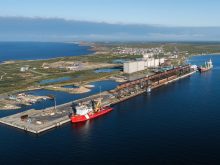The potential benefits of a Canada-European Union trade liberalization agreement are being overstated by supporters, suggests analysis by Library of Parliament researchers.
A study sponsored by the two governments and published before the launch of negotiations in 2009 predicted that a deal could result in a $10 billion increase in Canadian exports of goods to the EU by 2014 with European exports to Canada increasing by close to $20 billion.
Several billion dollars of that total would be in agricultural and food products.
Canadian trade minister Peter Van Loan regularly says a successful deal will open up $12 billion in potential new trade for Canadian exporters.
Read Also

Agriculture ministers commit to enhancing competitiveness
Canadian ag ministers said they want to ensure farmers, ranchers and processors are competitive through ongoing regulatory reform and business risk management programs that work.
However, researchers Alexandre Gauthier and Michael Holden argue in a study published by the Library of Parliament that those numbers exaggerate the potential because they are based on unlikely assumptions.
The government analysis assumes that a new World Trade Organization deal will be in place, although WTO talks have been stalled since 2008 and are entering their 10th year with no end in sight.
It also assumes Canada and the EU will agree to remove all trade barriers, including those in agriculture.
“The study assumes full elimination of tariffs and tariff-rate quotas in all industrial and agricultural sectors, including sensitive sectors,” Gauthier and Holden wrote.
“These outcomes are unlikely.”
They said the tariffs and import restrictions that are used to protect supply managed sectors are part of the negotiation, but “the government of Canada has said that it strongly supports supply management and will defend the supply management system with the same vigour as in all of its previous trade negotiations.”
They also argued that the EU is unlikely to make concessions on its non-tariff barriers that restrict agricultural imports if they exceed what it is required to do under WTO rules.
It means there will be little movement on two of Canada’s main agricultural objectives – gaining access for genetically modified seed varieties and increased Canadian livestock exports.
The parliamentary analysis said the EU will not be willing to include its strong financial support for European farmers as part of the negotiation.
Meanwhile, it said EU negotiators are targeting the Canadian Wheat Board export monopoly for wheat and barley, which the Canadian government argues will be decided domestically rather than through international trade deals.
The report said agriculture is one of the most difficult issues in the negotiations.
“While market access in agriculture is often the most contentious issue in bilateral and multilateral trade negotiations, it is expected to be even more so in CETA (Comprehensive Economic and Trade Agreement) negotiations as both Canada and the EU have major sensitivities in agriculture,” it said.
Canadian and EU officials will now review progress during the first five negotiating sessions to decide if a deal is possible by next year.
If not, they have said the talks will end.
An earlier effort to negotiate a trade deal ended in 2006 when it was clear a deal was not possible.
TIME LINE OF CANADA, EU TRADE TALKS
March 18, 2004:
EU and Canadian leaders agree to a framework for a new Trade and Investment Enhancement Agreement.
Oct.16, 2008:
Canada and the EU release a joint study on Assessing the Costs and Benefits of a Closer EU-Canada Economic Partnership, which suggested freer trade between the two could boost Canada’s gross domestic product by $12 billion by 2014.
March 5, 2009:
Canada and the EU release the Joint Report on the EU-Canada Scoping Exercise, which outlines a broad negotiating agenda.
May 6, 2009:
In Prague, Czech Republic, Canadian and European leaders announce the launch of negotiations toward a Comprehensive Economic and Trade Agreement.














